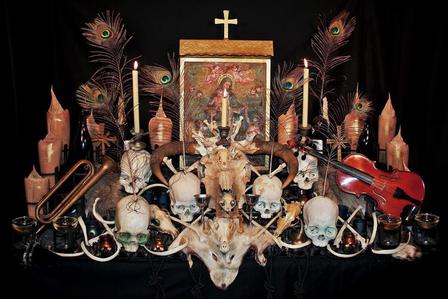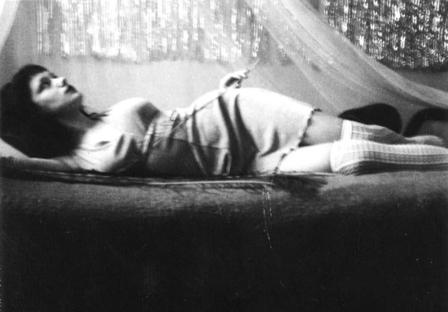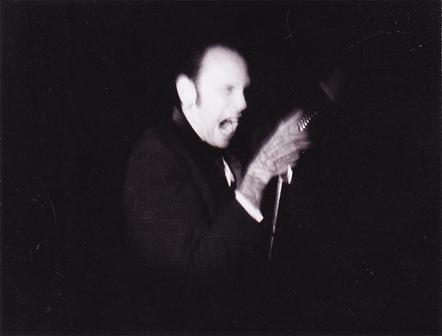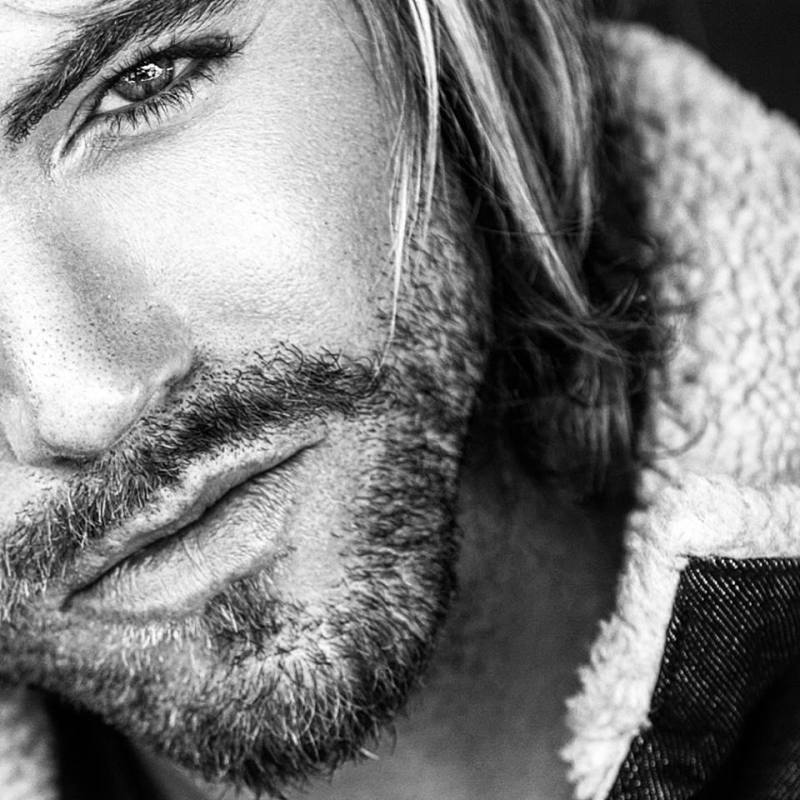Sean Yseult has started her career in the art world many years ago, while studying in Parsons School of Design in New York city. After “White Zombie” was formed, Sean had spent thirteen years playing in the multiplatinum band around the world. After many years of band’s broke up it seems that not much have changed for Sean. Her “empy space” has gave to Sean the chance to return to her roots, becoming an artist, in a broad sense. At least, watching some of her works I really catching myself thinking that Sean is really good artist. Basically, “artist” it’s not only the person who releases records and plays in front of crowd of fans. Artist is also a person who can masterfully put his idea, concept, soul and inner message, creating the masterpiece.
In the interview for Punk Globe magazine, Sean Yseult told about her main sources of inspiration, about her work as photographer and designer. About the most memorable White Zombie’s shows and her personal aspirations.

Punk Globe: Preparing for the interview, I found a quote where you described your experience as an artist. Honestly, I can understand it. When I started writing , I wrote three or four articles a day. But after some experience, I began to see the negative side of this kind of writing. Can you tell me, has your opinion changed from your earlier work?
Sean: I tend to work in spats, instigated by inspiration. Sometimes that inspiration comes from a dream or a vision I have in my head, that I feel I need to recreate on paper. Because I also do graphics and write music, I often focus on one of those outlets for six months at a time, depending on the project I want to complete. It’s not the fastest way to become known in one area, but I have to follow my visions, or the music I hear in my head.
Punk Globe: Looking at some of your work, first of all I had a feeling of artistic performance. If we are talking about a large-scale composition, then you pay attention to the composition and details. How do your ideas appear?
Sean: Often out of nowhere, in a dream or just a vision I have. That would be the case for my “Mississippi Mermaids” show, with girls encapsulated in bottles floating on water, and also my new show for the 300th Centennial of New Orleans, “They All Axed For You.” I had one dream where I saw elephants storming through the Mississippi River. I had another dream, just after my mother passed away, that we were walking along the path of Audubon Park and the path was lined with pairs of animals from the Audubon Zoo, in a very reverential manner. I am recreating these dreams along with other combinations of photos I shot in all of my favorite New Orleans locations and of animals at the New Orleans Zoo, which is what the title is a reference to. With a show like “Soirée D’Evolution”, the history of decadent secret societies parties in late 1800’s New Orleans combined with Dutch Master’s still life paintings was my inspiration. Spending time at the Louvre, rereading Edward Gorey books of my childhood - so many things inspire me.
Punk Globe: Speaking of painting, many of the artists work during years and decades! They form their idea, change it and bring it to life. Is it similar in your case ?
Sean: Yes, although my medium is photography, I do make changes during the process and things always take longer than you plan. The vision in your head doesn’t always work out exactly as you had planned on paper, so adjustments and new ideas are necessary - you have to be flexible and go with the flow. That said, sometimes it all falls together perfectly!

Punk Globe: Recently I got the first album by Corrosion Of Conformity, you are listed in it as a photographer. It was before you started playing bass in White Zombie. Have you always had a passion for photography?
Sean: Yes - the whole reason I was in New York and able to start the band White Zombie together is because I was on scholarship at Parsons for my photography. I spent most of my childhood at the North Carolina School of the Arts. I had been in the ballet department since the age of eleven, but right before my senior year I broke my foot - in class! I had to switch departments and tried out the Visual Arts department for the summer. I did well enough for them to offer me a scholarship for my senior high school year and it was mostly based on my photography work, where I was already juxtaposing strange things together to create narratives. I also had been drawing psychedelic designs since childhood and enjoyed all of the design assignments.
Punk Globe: Let's focus on your career in White Zombie. How much did your role in the band help your current career? I do not mean fame . I’m talking more about your past experiences as a member of White Zombie.
Sean: That’s an interesting question. Because nothing about White Zombie really contributes to what I do currently - as I said above, I was already focused on becoming a photographer and designer in high school. The one thing I think we can all thank White Zombie for is getting over our shyness - as in most cases, our band was composed of social outcasts and not very outgoing. It took a lot to get psyched up to face an audience and get on stage - it was always something I hated as a child pianist. I actually had a nervous breakdown at age twelve over it and quit, it made me so ill and filled with dread to get up there in front of people. White Zombie helped me overcome all of that and realize how meaningless it is to worry about what people think. That boldness entitles you then to take more chances in life, which I think is extremely important for a creative person.

Punk Globe: There are performers whose fame goes beyond their public persona's . The Sex Pistols - one album and that's it. Total punk infection. Although, I don't compare Sex Pistols to White Zombie. But in both cases I can see that the performances of these two bands made you and them legendary. But if we talk about emotionality, did you set the goal of creating a unique and emotional show or just giving yourself up to your emotions?
Sean: We certainly set out to create a unique show, with our graphics and illustration backgrounds, but I don’t know about emotion. In the beginning we were really pioneering, just moving forward into the void not knowing exactly what we would create musically next - it eventually took form and direction. But with our backgrounds in art and design, it was really just a detour for me - which having trained early in life as a musician, I was well equipped for. And a fun detour, at that!
Punk Globe: What was it like to look at people's reaction to your activities while you were playing? As you just mentioned, you were one of the pioneers of alternative metal. And the reaction to your performances varied. Although I can not help noticing your shows in Europe, where the public became part of one big, pulsating mass.
Sean: Astounding. Once we broke through and started going platinum, then double and triple platinum, the size of the crowds and their reaction was the craziest high you could ever have - adrenaline times a thousand! We were headlining crowds of 10,000 or so on our own during the last few years, and when we played festivals - to see 80,000 - 300,000 people jumping around and singing in unison to your music was just incredible. The band and audience become one and feed off each other’s energy.
Punk Globe: Let's talk about what you are doing now. Is there still a place in your life for music? Because I know that in 2013, you, and your band Star & Dagger released their debut album - a very interesting album. Are you planning to continue with music?
Sean: I would love to but music is taking a backseat to my photography and design work right now. I did write a soundtrack piece for Waxworks Records recently, and last year I composed five pieces for a modern dance performance, which was really fun for me. I am avoiding playing the bass for a while as it has been the source of continual pain for me over the years. I recently had surgery and work done on my back and wrist to deal with that. I’m finally out of pain and not in a hurry to have it return. I also have expanded my design line to wallpaper recently and that is keeping me busier than I thought - the line is expanding soon to more interior design items and is already going up in certain Live Nation clubs and theaters.
Photography by Sean Yseult

Punk Globe: After honing your work with photography, you began to be actively exhibited. First of all, this is the exhibition "BSides: Musicians Show Their Flip Side as Photographers" that took place in the Heron Arts gallery a couple of years ago. In which also showcased Greg Dulli from The Afghan Whigs and Moby. How interesting was it to work on that event and what was your thoughts?
Sean: I’ve actually been showing in galleries since 2002. Heron Arts tapped me to curate the B-Sides show, which was great fun for me. I researched famous musicians, that I hadn’t even met yet like Moby, and friends like Dave Catching (Eagles of Death Metal) Greg Dulli and Pat Sansone (Wilco.) I found they were all doing beautiful work, and many of them had never exhibited before. It was really great to organize so many like minded musicians that were also so visual. Mike Watt, Chris Coleman - so much talent, and all lovely people!
Punk Globe: How different do you feel when you first go on stage and when does your exhibition take place? I mean the reactions from all of the people to your work. After all, in fact it is like - exciting your adrenaline. These feelings, do they differ?
Sean: No - it is very similar - nerve wracking! A group show like “B-Sides” takes the pressure off a bit - like being in a band. There are others there with you to share the anxiety and help diminish it. But having a solo show takes me back to taking the stage as a child with only me and a grand piano - a bit intimidation. But thank goodness usually the reaction is quite nice and you feel good about all of your work that went into it at the end.
Punk Globe: The theme of your work is dominated by Gothic motifs. Honestly, my main associations are works of medieval painters: Caravaggio, Dürer, somewhere even Cezanne. Can you tell me, your inspirations, who inspired you?
Sean: For painters, love Gustave Moreau, Hieronymus Bosch, Egon Schiele, and Gustav Klimt. In photography, I have always loved Joel Peter Witkin, and finally met him this past year. He is a true hero and inspiration for me. Two other huge inspirations are Clarence Laughlin, who did the beautiful book on dilapidated plantation homes “Ghosts Along the Mississippi” , and the amazing photographer Bellocq, who photographed prostitutes in the New Orleans brothels circa early 1900’s. As a child my parents always had a copy of “Wisconsin Death Trip” on the coffee table, and plenty of Edward Gorey books lying around that definitely inspired my dark side.
Recently I was in Hong Kong and became so inspired by the interior designs of the night clubs by Ashley Sutton, who wrote a trilogy of books that he then based the spectacular “Iron Faeries” bar and club, and the dream like “Ophelia” bar and club, a beautiful take on an opium den.
Photography by Sean Yseult

Punk Globe: One of my friends once said that the city in where you live, inevitably appears on his face. After the breakup of White Zombie, you moved to New Orleans, where you continue to live now. How do you feel that or where did New Orleans find your reflection in your work?
Sean: I moved to New Orleans because it inspires me, and still stimulates me visually, daily. Everything from the decrepit graveyards and dilapidated homes to the grand mansions on St. Charles and enormous live oaks, all well over a hundred years old…. then of course the culture of voodoo mixed with Catholicism, the decadent partying and entertaining, the over the top restaurants and 24 hour bars and clubs - one huge historic den of iniquity. What creative person would not be drawn to this town?
Punk Globe: In your case you’re right! And finally – the last question: What are your plans for the future?
Sean: More travel, more photography, more design, and more music!
Photography by Sean Yseult




